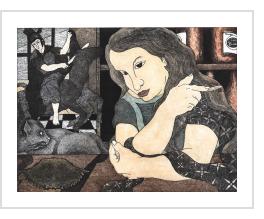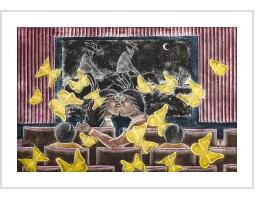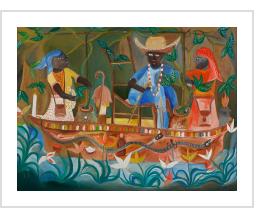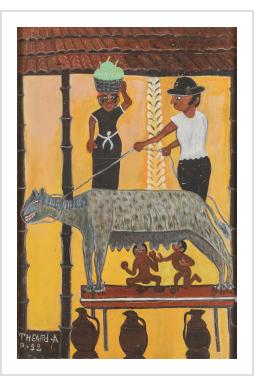Rodolfo Morales Obituary (New York Times)
by IndigoAdminFebruary 6, 2001
Rodolfo Morales, Painter of Peasant Life in Mexico, Dies at 75
By GINGER THOMPSON
MEXICO CITY, Feb. 5 — Rodolfo Morales, whose surreal paintings of rural Mexican culture won acclaim around the world, died last Tuesday in Oaxaca. He was 75.
He was being treated for pancreatic cancer, according to news reports in Mexico.
Mr. Morales was born in 1925 in a small Indian village in Oaxaca, and although he traveled extensively around Europe and Latin America, most of his art was inspired by dreamlike memories of his native land. Many of his paintings are primitive, with subjects — mostly women — whose oversize faces do not correspond with their small feet and hands. The warmth and color of his work spin the mundane toils of a peasant village into magical scenes whose images include brides on bicycles, dancing angels and puppies with human expressions.
Mr. Morales often said that he did not like to talk about the meaning of his paintings but that he derived great satisfaction from watching others find something of themselves in his mystical settings.
"I try not to repeat myself," he said last year in an interview with the Mexican newspaper Reforma, "but all I do is paint from the time I get up until the time I lie down."
A mild-mannered man with expressive eyes and a gentle voice, Mr. Morales recalled growing up as a solitary child, picked on by other children, he said, because he was "different" and liked to draw. At 23, he moved to Mexico City to study art at the Academy of San Carlos and then began a 32-year career as a high school art teacher.
For extra money, he organized exhibitions of his work in small galleries around the capital. In 1975, when he was approaching 50, his paintings were noticed by Rufino Tamayo, the dean of Oaxacan painters. Mr. Tamayo helped Mr. Morales make contacts with art critics and gallery owners around the world. The two artists, along with Francisco Toledo, became a kind of triumvirate of masters whose work made Oaxaca an internationally renowned center for contemporary art.
Mr. Morales was commissioned for various government and corporate projects, and his work was shown in individual exhibitions in galleries and museums throughout the world. Some critics dismissed his art as stale and folksy but most praised him as an imaginative and generous spirit.
Mr. Morales said that fame frightened him in many ways.
"Many critics speak too much of young artists with such success that it sends them right to the grave," he said in the interview with Reforma. "Painters are poor and by earning thousands of dollars, they become drunk until they die."
In the late 1980's, Mr. Morales had finally earned enough to quit teaching, move back to Oaxaca and dedicate himself full time to his art. He created a foundation devoted to restoring the battered monuments of his dusty hometown, Ocotlan. He helped restore the 16th-century Convent of Santo Domingo and a 17th- century church in the town of Santa Ana Zegache.
"I came here to live in my memories," Mr. Morales said in a 1995 interview. "Nostalgia and melancholy are very important to me."
In an effort to promote art and culture in Oaxaca, Mr. Morales's foundation has organized workshops, provided materials to aspiring artists and planted thousands of new copal trees that not only give life to the barren landscape but also provide wood for the creation of the fantastical hand-painted animals known in Mexico as alebrijes.
He leaves no immediate survivors.
Last year he celebrated his 50th anniversary as an artist with a retrospective of more than 100 pieces at the Contemporary Museum of Art in Oaxaca. Two books about him were also published last year, including a biography whose title is loosely translated as "The Man of Dreams."
Copyright 2001 The New York Times Company




